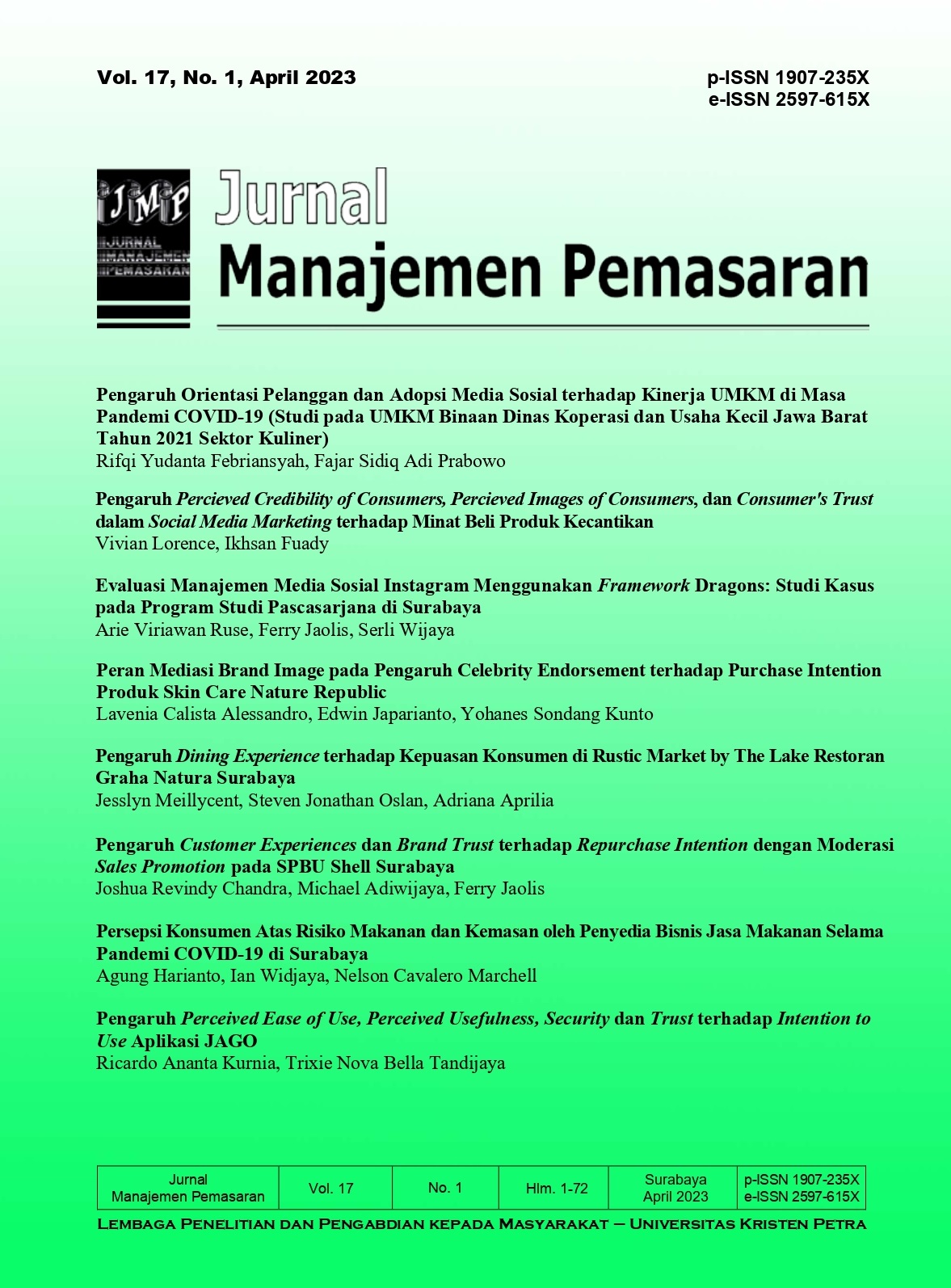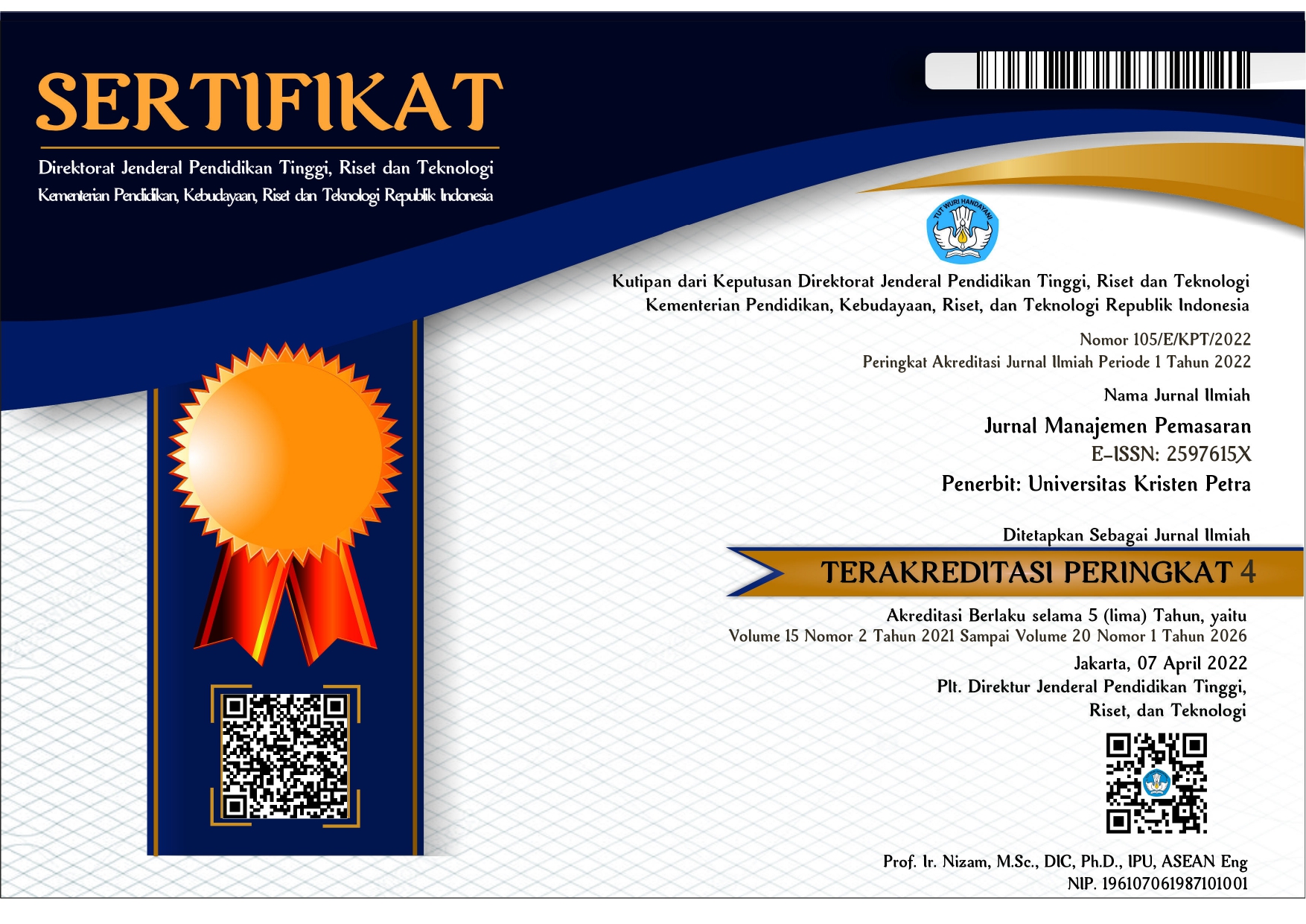PENGARUH PERCEIVED EASE OF USE, PERCEIVED USEFULNESS, SECURITY DAN TRUST TERHADAP INTENTION TO USE APLIKASI JAGO
DOI:
https://doi.org/10.9744/jmp.17.1.64-72Keywords:
perceived ease of use, perceived usefulness, security, trust, intention to use, Aplikasi JAGOAbstract
Intention to use merupakan salah satu faktor penting yang harus diperhatikan oleh pengembang bank digital dalam membuat keputusan untuk tetap menjadi pilihan utama pengguna bank digital. Penelitian ini bertujuan untuk mengetahui pengaruh dari perceived ease of use, perceived usefulness, security dan trust terhadap intention to use. Jenis penelitian yang dilakukan adalah penelitian kuantitatif dengan teknik purposive sampling menggunakan software smartPLS v4. Hasil penemuan ini menemukan bahwa perceived ease of use dan security tidak memiliki pengaruh secara langsung terhadap intention to use, namun perceived usefulness dan trust memiliki pengaruh yang signifikan dan positif terhadap intention to use aplikasi JAGO.
References
Abdullah, F., Ward, R., & Ahmed, E. (2016). Investi-gating the influence of the most commonly used external variables of TAM on students’ Perceived ease of use (PEOU) and Perceived usefulness (PU) of e-portfolios. Computers in Human Behavior, 63, 75-90. https://doi.org/10.1016/j.chb. 20 16.05.014
Alkhowaiter, W. A. (2020). Digital payment and banking adoption research in Guld countries: A systematic literature review. International Journal of Information Management, 53, 102102. https://doi.org/10.1016/j.ijinfomgt.2020.102102
Anthony, D., & Mutalemwa, D. K. (2014). Factors influencing the Use of Mobile Payments in Tanzania: Insight from Zantel’s Z-pesal services. The Journal of Language, Technology & Entrepreneurship in Africa, 5(2), 69-93.
Anjelina. (2018). Persepsi konsumen pada penggunaan e-money. Journal of Language, Technology & Entrepreneurship in Africa, 2(2), 219-231
Azali, K. (2016). Cashless in Indonesia: Gelling Mobile E-frictions? Journal of Southeast Asian Economies, 33(3), 364-386. http://www.jstor.org/ stable/44132411
Chawla, D., & Joshi, H. (2019). Consumer attitude and intention to adopt mobile wallet in India – An empirical study. International Journal of Bank Marketing, 37(7), 1590-1618. https://doi.org/10.1108/IJBM-092018-0256
Cobanoglu, C., Yang, W., Shatskikh, A., & Agarwal, A. (2015). Are consumers ready for mobile payment? An examination of consumer acceptance of mobile payment technology in restaurant industry. Hospitality Review Journal, 31(4), 1-18.
Davis, F. D. (1989). Perceived usefulness, perceived ease of use, and user acceptance of information technology. MIS Quarterly, 13(3), 319-340. https://doi.org/10.2307/249008
Davis, F. D., Bargozzi, R. P., & Warshaw, P. R. (1989). User acceptance of computer technology: A comparison of two theoretical models. Manage-ment Science, 35(8), 982-1003. https://doi.org/10.1287/mnsc.35.8.982
Farooq, A., Ahmad, F., Khadam, N., Lorenz, B., & Isoaho, J. (2020). The impact of perceived security on intention to use e-learning among students. 2020 IEEE 20th International Conference on Advanced Learning Technologies (ICALT). https://doi.org/10.1109/icalt49669.2020.00115
Hansen, J. M., Saridakis, G., & Benson, V. (2018). Risk, trust, and the interaction of perceived ease of use and behavioral control in predicting consumers’ use of social media for transactions. Computers in Human Behavior, 80, 197-206. https://doi.org/10.1016/j.chb.2017.11.010
Kanchanatanee, K., Suwanno, N., & Jarernvongrayab, A. (2014). Effects of attitude toward using, perceived usefulness, perceived ease of use and perceived compatibility on intention to use e-marketing. Journal of Management Research, 6(3). https://doi.org/10.5296/jmr.v6i3.5573
Kumala, D. C., Pranata, J. W., & Thio, S. (2020). Pengaruh perceived ease of use, perceived usefulness, trust, dan security terhadap minat penggunaan GoPay pada generasi X di Surabaya. Jurnal Manajemen Perhotelan, 6(1), 19-29. https://doi.org/10.9744/jmp.6.1.19-29
Lai, P. C. (2018) Security as an extension to TAM model: Consumer’s intention to use a single platform e-payment. Asia-Pacific Journal of Management Research and Innovation, 13(3-4), 110-119. https://doi.org/10.1177/2319510x18776405
Lee, Y., Kozar, K. A., & Larsen, K. R.T. (2016). The technology acceptance model: Past, present, and future. Communications of the Association for Information Systems, 12(1), 752-783. https://doi.org/10.17705/1CAIS. 01250
Marangunić, N., & Granić, A. (2014). Technology acceptance model: a literature review from 1986 to 2013. Universal Access in the Information Society, 14, 81-95. https://doi.org/10.1007/s10209-014-0348-1
Moslehpour, M., Pham, V. K., Wong, W. K., & Bilgiçli, İ. (2018). E-purchase intention of Taiwanese Consumers: Sustainable Mediation of Perceived usefulness and Perceived ease of use. Sustainability, 10(1), 234. https://doi.org/10.3390/su10010 234
Phonthanukitithaworn, C., Sellitto, C., & Fong, M. W. L. (2016). An investigation of mobile payment (m-payment) services in Thailand. Asia-Pacific Journal of Business Administration, 8(1), 37-54. https://doi.org/10.1108/APJBA-10-2014-0119
Ramos, F. L., Ferreira, J. B., Freitas, A. S. D., & Rodrigues, J. W. (2018). The effect of trust in the intention to use m-banking. Brazilian Business Review, 15(2), 175-191. https://doi.org/10.15728/bbr.2018.15.2.5
Seetharman, A., Kumar, K. N., Palaniappan, S., & Webber, G. (2017). Factors influencing behavioural intention to use the mobile wallet in Singapore. Journal of Applied Economics and Business Research, 7(2), 116-136.
Shaw, N. (2014). The mediating influence of trust in the adoption of the mobile wallet. Journal of Retailing and Consumer Services, 21(4), 449-459. https://doi.org/10.1016/j.jretconser.2014.03.008
Singh, N., & Sinha, N. (2020). How perceived trust mediates merchant's intention to use a mobile wallet technology. Journal of Retailing and Consumer Services, 52, 101894. https://doi.org/10.1016/j.jretconser.2019.101894
Suh, B., & Han, I. (2002). Effect of trust on customer acceptance of Internet banking. Electronic Commerce Research and Applications, 1(3-4), 247-263. https://doi.org/10.1016/s1567-4223(02)00017-0
Taherdoost, H. (2017). Understanding of e-service security dimensions and its effect on quality and intention to use. Information and Computer Security, 25(5), 535-559. https://doi.org/10.1108/ICS-09-2016-0074
Upadhyay, P., & Jahanyan, S. (2016). Analyzing user perspective on the factors affecting use intention of mobile based transfer payment. Internet Research, 26(1). https://doi.org/10.1108/IntR-05-2014-0143
Venkatesh, V., Morris, M. G., Davis, G. B., & Davis, F. D. (2003). User Acceptance of Information Technology: Toward a unified view. MIS Quarterly, 27(3), 425-478. https://doi.org/10.2307/30036540
Wandira, R., & Fauzi, A. (2022). TAM approach: Effect of security on customer behavioral intentions to use mobile banking. Journal of Humanities and Social Sciences innovation, 2(2). https://doi.org/10.35877/454RI.daengku872
Downloads
Published
How to Cite
Issue
Section
License
Copyright (c) 2023 Ricardo Ananta Kurnia, Trixie Nova Bella Tandijaya

This work is licensed under a Creative Commons Attribution 4.0 International License.

















